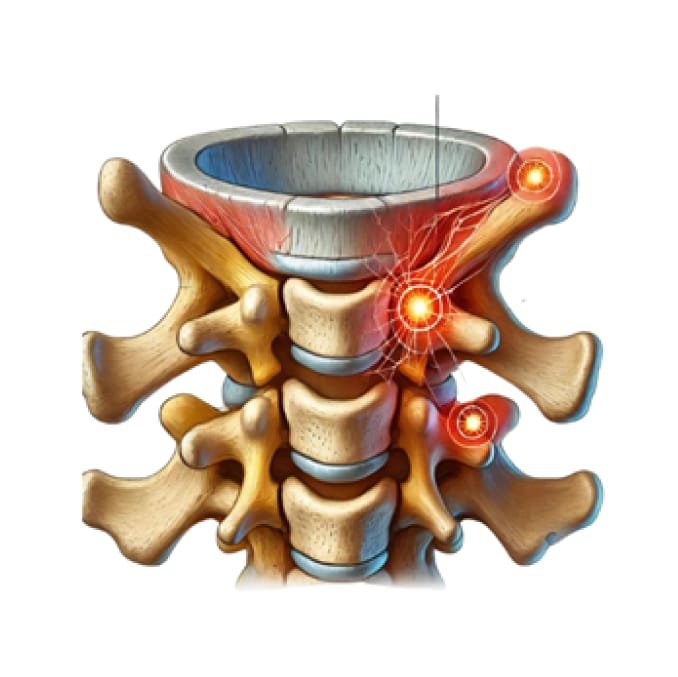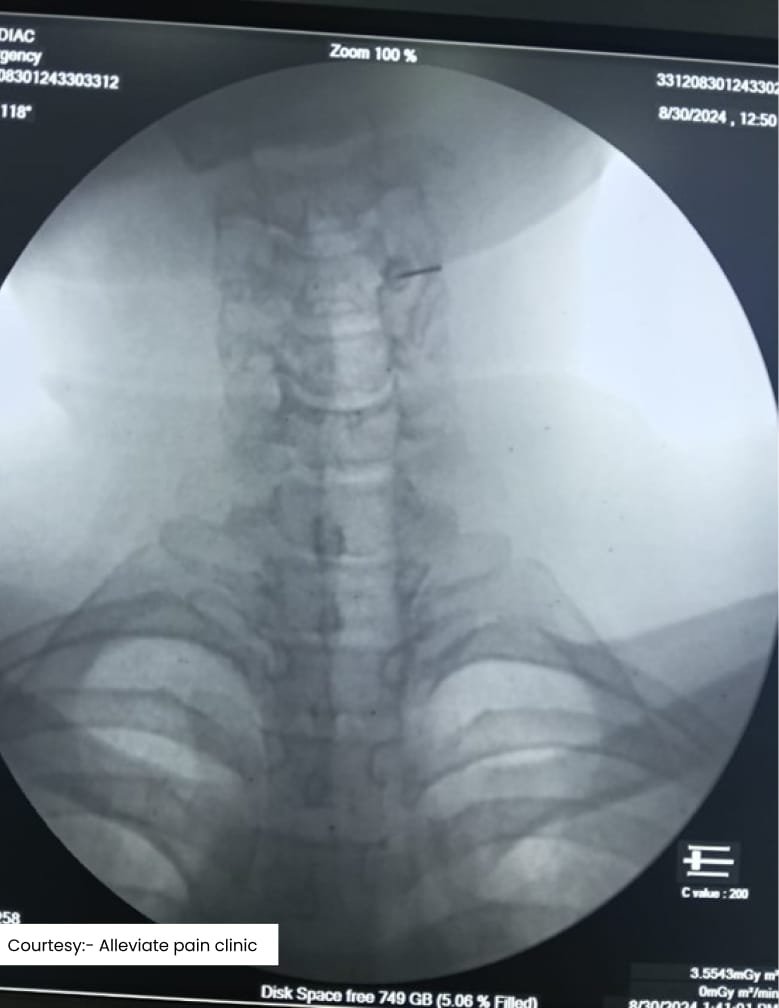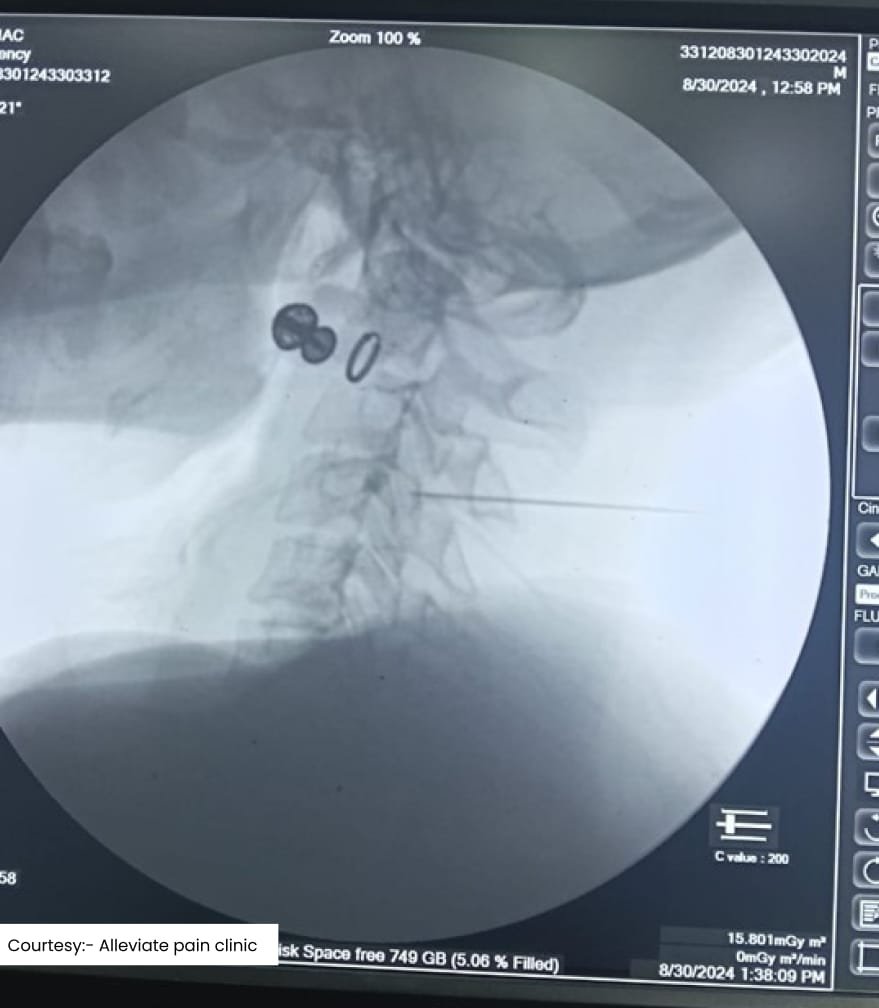
Cervical facet joint syndrome is a common but often overlooked cause of neck pain, affecting the small, intricate joints that allow movement between the vertebrae of the neck. At Alleviate Pain Clinic, we combine advanced imaging-guided interventions with a comprehensive, multidisciplinary approach to accurately diagnose and treat this condition, ensuring our patients receive effective, long-lasting relief.
Anatomy of the Cervical Facet Joints
The cervical spine is composed of seven vertebrae, labeled C1 through C7. Between each of these vertebrae are facet joints—small, paired joints located on either side of the vertebrae. These joints enable the smooth gliding and rotation of the neck and provide stability. Each facet joint is covered with cartilage and surrounded by a capsule filled with synovial fluid, which lubricates the joint and prevents friction during movement.
Over time or due to injury, these joints can become inflamed or worn down, leading to cervical facet joint syndrome. This condition can manifest as localized pain, restricted movement, or even referred pain to other areas, such as the shoulders, upper back, and head.
Causes of Cervical Facet Joint Syndrome
Cervical facet joint syndrome typically results from:
- Degenerative changes: Natural aging can lead to wear and tear of the facet joints, causing the cartilage to degrade and the joints to stiffen.
- Trauma or injury: Whiplash from car accidents or sports injuries may cause sudden trauma to the cervical spine, leading to inflammation or damage to the facet joints.
- Poor posture: Long-term poor posture, such as prolonged sitting with a forward head position, can strain the facet joints.
- Arthritis: Osteoarthritis or rheumatoid arthritis can affect the cervical facet joints, causing pain and stiffness.
Symptoms of Cervical Facet Joint Syndrome
Patients with cervical facet joint syndrome typically experience a range of symptoms, which may include:
- Neck pain: Localized pain that worsens with neck movement, particularly twisting or bending.
- Headaches: Pain that starts in the neck and radiates to the back of the head.
- Referred pain: Pain can radiate to the shoulders, upper back, and even down the arms.
- Stiffness: Difficulty turning the head or a feeling of tightness in the neck.
- Tenderness: Upon palpation of the affected facet joints, patients may report tenderness or discomfort.
- Pain during certain movements: Such as extending the neck or rotating it to one side.

Symptoms caused by inflammation and arthritic wear and tear of cervical joints
The Problem of Missed Diagnosis
Cervical facet joint syndrome is frequently underdiagnosed or mistaken for other conditions like herniated discs, muscle strain, or even migraines. This is largely due to the fact that the symptoms of facet joint syndrome overlap with many other neck and spine disorders. Without a precise diagnosis, patients may endure years of ineffective treatment.
At Alleviate Pain Clinic, we prioritize thorough clinical assessments and precise diagnostics to avoid missed diagnoses. Our team specializes in distinguishing cervical facet joint syndrome from other causes of neck pain, ensuring a targeted and effective treatment plan.
Investigation: Clinical Tests and Imaging
Diagnosing cervical facet joint syndrome begins with a detailed clinical evaluation. Key tests include:
- Palpation: Applying pressure to the cervical facet joints to assess tenderness.
- Range of motion tests: Checking for pain during specific neck movements.
- Nerve blocks: A diagnostic facet joint injection (using a local anesthetic) can help confirm the source of pain by temporarily numbing the joint. If pain relief occurs, the facet joint is likely the cause.

Imaging Tests
- X-rays: Can reveal joint degeneration, osteoarthritis, or misalignment in the cervical spine.
- MRI (Magnetic Resonance Imaging): Offers detailed images of the cervical spine, allowing doctors to visualize soft tissues, including the cartilage within the facet joints.
- CT (Computed Tomography) scans: Often used in conjunction with X-rays, these scans offer a detailed cross-sectional view of the spine and joints.
At Alleviate Pain Clinic, we also utilize fluoroscopic guidance to ensure precision during diagnostic and therapeutic injections.
Treatment: Image-Guided Procedures and Multidisciplinary Care at Alleviate Pain Clinic
For patients suffering from cervical facet joint syndrome, a tailored treatment plan is critical. We focus on alleviating pain and restoring function using a combination of cutting-edge interventional procedures and holistic care.
Image-Guided Procedures
- Facet joint injections: An injection of a local anesthetic and corticosteroid into the affected facet joint to reduce inflammation and relieve pain.
- Radiofrequency ablation (RFA): This procedure uses heat to destroy the nerve fibers transmitting pain from the affected facet joints, offering long-term relief.
- Medial branch blocks: A targeted injection that blocks the nerves responsible for transmitting pain signals from the facet joints to the brain.


Fluoroscopic guided medial branch block for cervical facet joint syndrome sone at Alleviate Pain Clinic
Each of these procedures is performed using image guidance—such as fluoroscopy or ultrasound—to ensure precise needle placement and maximum effectiveness. This approach minimizes complications and maximizes pain relief.
Multidisciplinary Care Approach
At Alleviate Pain Clinic, we understand that treating cervical facet joint syndrome requires more than just injections. We offer a comprehensive, multidisciplinary approach that includes:
- Physical therapy: Customized exercises to improve posture, flexibility, and neck strength, reducing the strain on facet joints.
- Regenerative medicine: Innovative treatments like platelet-rich plasma (PRP) therapy may help repair damaged tissues in the facet joints.
- Chiropractic care and massage therapy: Complementary treatments to alleviate tension in surrounding muscles and improve spinal alignment.
- Lifestyle modifications: Ergonomic assessments and guidance on posture, activity modifications, and stress reduction techniques to prevent further joint damage.
Our holistic, patient-centered care model ensures that each individual receives the right combination of treatments to not only relieve pain but also improve long-term quality of life.
Conclusion
Cervical facet joint syndrome is a common yet frequently missed cause of chronic neck pain. At Alleviate Pain Clinic, we use state-of-the-art diagnostic tools, including image-guided procedures, to provide an accurate diagnosis and effective, multidisciplinary treatment. If you’re experiencing neck pain, our team of specialists is here to help you find relief and regain control of your life.
Reach out to Alleviate Pain Clinic today to schedule a consultation and begin your journey toward a pain-free life.
References
Anatomy and Pathophysiology of Cervical Facet Joints
- Bogduk, N. (2011). Cervical facet joints: Anatomy and significance. Pain Physician, 14(4), E309-E334.
- Cohen, S. P., & Raja, S. N. (2007). Pathogenesis, diagnosis, and management of cervical facet joint pain. Anesthesiology, 106(3), 591-614.
Causes and Symptoms of Cervical Facet Joint Syndrome
- Manchikanti, L., et al. (2015). Prevalence of facet joint pain in chronic spinal pain of cervical and lumbar regions. Pain Physician, 18(4), E365-E382.
- Kalichman, L., & Hunter, D. J. (2007). Diagnosis and conservative management of facet joint pain. Journal of Back and Musculoskeletal Rehabilitation, 20(1), 29-36.
Missed Diagnosis of Cervical Facet Joint Syndrome
- Lord, S. M., et al. (1996). Cervical zygapophysial joint pain: A distinct clinical entity. Pain, 68(1), 79-86.
- Dwyer, A., et al. (2014). The missed diagnosis of cervical facet pain in chronic neck pain patients. Clinical Journal of Pain, 30(3), 233-239.
Investigation: Clinical Tests and Imaging
- Manchikanti, L., et al. (2002). Facet joint pain: Evidence-based management and interventional treatments. Pain Physician, 5(1), 71-82.
- Masharawi, Y., & Rothschild, B. M. (2014). Facet arthrosis in the cervical spine: A radiological analysis. The Spine Journal, 14(6), 898-904.
Image-Guided Procedures for Treatment
- Dreyfuss, P., et al. (2000). Efficacy and validity of radiofrequency neurotomy for chronic cervical facet pain. Spine, 25(10), 1270-1277.
- Cohen, S. P., et al. (2010). Cervical facet joint blocks and radiofrequency neurotomy: A systematic review. Regional Anesthesia and Pain Medicine, 35(5), 473-488.
Multidisciplinary Care in Chronic Pain Management
- Gatchel, R. J., & Okifuji, A. (2006). Evidence-based scientific data documenting the treatment and cost-effectiveness of comprehensive pain programs for chronic nonmalignant pain. The Journal of Pain, 7(11), 779-793.
- van Dieën, J. H., et al. (2012). The contribution of multidisciplinary care to chronic neck pain rehabilitation: A systematic review. European Spine Journal, 21(8), 1546-1560.





